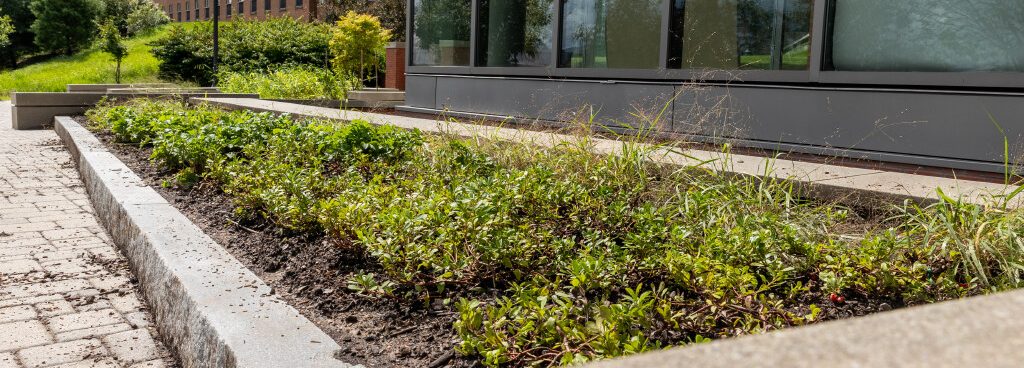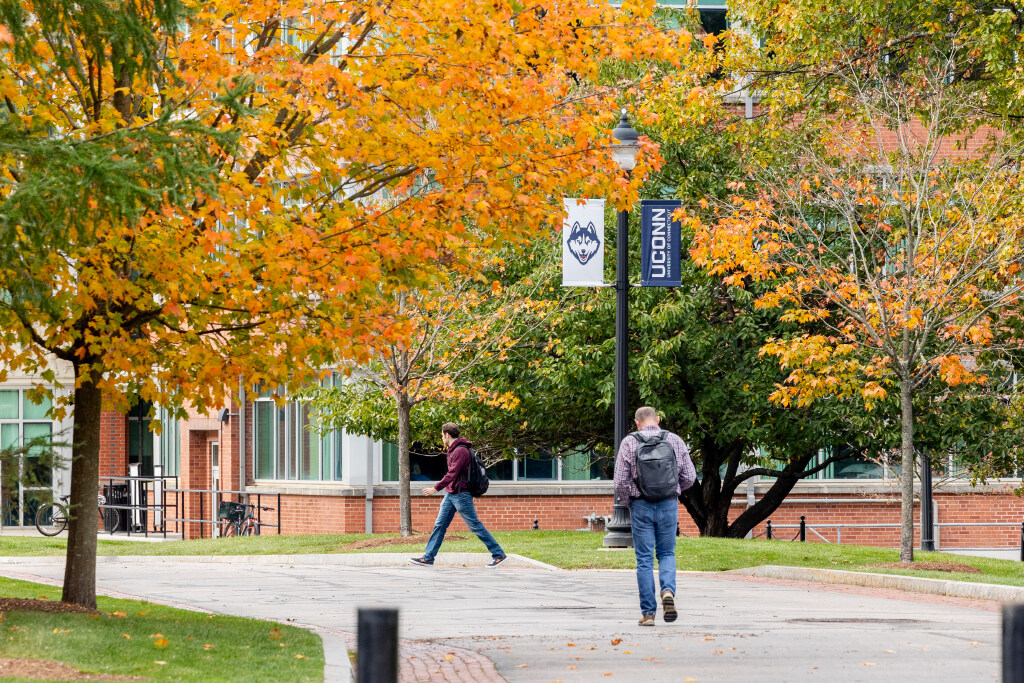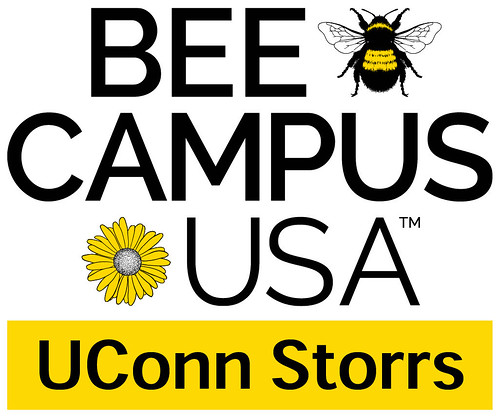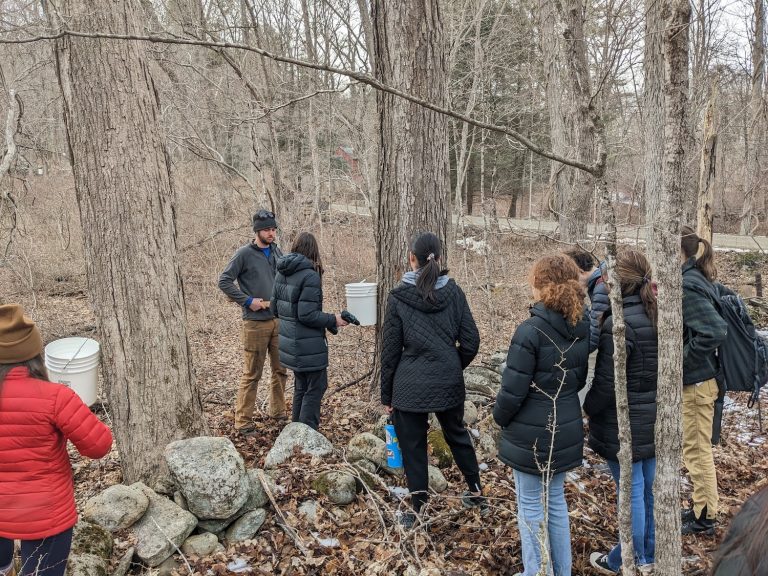
Grounds, Open Areas, & Conservation
Keeping our campus beautiful
Read more below about how UConn works to maintain beautiful and healthy campus grounds and wildlife.
Hillside Environmental Education Park (HEEP)
The Hillside Environmental Education Park (HEEP) is a 165-acre preservation area located on UConn’s North Campus. It is situated alongside Discovery Drive, which opened in 2016 and is the northern-most gateway entrance to the main campus. The preserve consists of uplands, meadows, woodlands, wetlands (including vernal pools) and riparian zones around Cedar Swamp Brook, which runs through the HEEP to Mansfield’s Pink Ravine. The park includes a network of hiking trails extending north from a trailhead near the C-Lot to Hunting Lodge Road and Discovery Drive. The trails feature interpretive signs, many of which were added in 2018, a wildlife observational platform, and a viewing platform overlooking the HEEP from the back of C-Lot.
The HEEP is a great complement to the Town of Mansfield’s open space network, which includes several parks, hiking trails and conservation lands. The HEEP trail entrance on Hunting Lodge Road inter-connects with a side entrance to the Town’s Shelter Falls Park across the street. The 165-acre HEEP is the result of two significant UConn projects: (i) remediation and closure of the former UConn Landfill, which operated into the early-1980s, and (ii) the North Hillside Road Extension (later re-named Discovery Drive), which enabled the future development of the UConn Tech Park on this section of the North Campus.
Background
On June 26, 1998, the Connecticut Department of Environmental Protection issued a consent order requiring the University to thoroughly evaluate the nature and extent of soil, surface water, and groundwater pollution emanating from the university landfill, former chemical pits, and an ash disposal site. The consent order also required UConn to propose and implement the remedial actions necessary to abate the pollution.
In response, the University developed a Wetland Mitigation Plan and Closure Plan which outlined strategies for remediating the landfill and former chemical pits. These strategies included the installation of a final cover over the landfill and chemical pits and the implementation of a long-term monitoring program for groundwater and surface water and a plan for post-closure maintenance of the cap and remediation systems. Additionally, parking facilities and habitat conservation areas were created for educational and recreational use.
The landfill remediation process resulted in the preservation of ~31 acres of wetlands and ~33 acres of uplands. Other notable activities include:
- Removal of ~40,000 cubic yards of contaminated soil and sediment
- Restoration of ~3 acres and creation of ~2 acres of wetlands and a created vernal pool
- Installation of impervious cap and a parking lot
- Installation of a leachate collection system
- Commitment to ground water monitoring for 30 years and wetland inspections for 10 years
Detailed project reports from the closure and remediation process are available at the the UConn Landfill Project website.
Remediation of the landfill and construction of the Hillside Environmental Education Park (HEEP) was completed during the summer of 2008. Extensive wetland monitoring continues throughout the project site which includes keeping a careful eye on types of vegetation, soil moisture levels, and wildlife.
Research
The HEEP provides numerous research and study opportunities in topics such as invasive species management, wildlife management and habitat enhancement, wetlands mitigation, vernal pool creation and management, to name a few! We encourage student groups and faculty members who may be interested in the Hillside Environmental Education Park site and its remediation plan to use the site for these research and educational
opportunities.
Please contact the Office of Sustainability at (860) 486-5773 if you would like to arrange a tour of the HEEP for your class or organization. Here you can find more information on the ecological value of wetlands, the importance of preserving connected open space, the 2005 amphibian study, Kristin Schwab's Design Project, and the Landfill Project.
In the News
-

A childhood love of nature blooms into a student career dedicated to sustainability
-

Ten years after the Hillside Environmental Education Park was created at the site of a former landfill, the park has been extended with additional land and trails.
- columns: 3
- pictures: true
- number-of-posts: 3
- read-more-text: Read More on UConn Today
- search: hillside-environmental-education-park
- show-excerpt: false
- show-date: false
- safe-fetch: 1
- attempted-request: https://today.uconn.edu/wp-rest/wp/v2/posts?posts_per_page=3&search=hillside-environmental-education-park&adjacent-posts=true&_embed
Haunted HEEP
The OS has hosted annual Haunted HEEP Trail Walks since October 2020. Groups of students are led on a spooky tour of the North Woods Trail, creating a terrifying experience of this treasured campus natural area! Thank you to UCTV for the video coverage of the 2023 Haunted HEEP!
Low impact development (or design) (LID) is a key component of UConn's commitment to sustainable management and growth. The University continues to seek out new opportunities to further incorporate low-impact design into the University's current construction and renovation projects. LID is a simple concept - designing and undertaking land re/development in a way that minimizes the effect of rain water run-off and contaminants that modify and pollute our rivers, streams and harbors. These designs can also be designated to lessen our impacts on other aspects of the environment, including physical waste reduction through composting and recycled building materials. Be sure to check out the LID tour that was developed by the Natural Resources Conservation Academy, a summer program for high school students who are mentored by faculty and graduate students from the Dept. of Natural Resources and the Environment.
Goals
The University of Connecticut is pursuing many initiatives to reduce environmental degradation and encourage smart building throughout campus. Current university goals include:
- Identify opportunities to further incorporate LID components in the University's current construction and renovation projects.
- Record and photo-document storm water management practices currently employed at the University to demonstrate compliance and best practices.
- Explore the potential for implementing "green roofs" at various locations, including the new library at the Avery Point campus and the new Bolton Road parking garage.
- Serve as an advisory figure in the upcoming North Campus planning process, guiding UConn's growth while remaining sensitive to our environmental "footprint."
Initiatives and Progress
In March 2007, the University of Connecticut adopted an additional Sustainable Design & Construction Policy.pdf, which specifies the University's objectives to plan, design, construct, renovate and maintain sustainable, energy- and water-efficient buildings.
- Composting: The agricultural composting facility has been operating since late-August 2010 and, according to Farm Services, is composting more manure, leaves and landscaping waste than was originally projected – at the rate of about 70 tons of manure and 20 yards of leaves/landscaping waste per windrow.
- Burton Family Football Complex and Mark R. Shenkman Training Center.pdf: The Burton/Shenkman facility has been a phenomenal success. The joint building was the first NCAA LEED registered building and the first LEED Silver certified NCAA facility.
- The North Hillside Road Extension Project: The University is working with Fuss & O'Neill, the project's environmental consultants, to outline an implementation plan including low-impact development features relating to site selection, promotion of alternative transportation, sustainable management and re-use of stormwater, overall water efficient design and light pollution reduction.
- Raingardens: UConn has two Raingardens located in the Towers area and near Mansfield Apartments. Raingardens protect water quality by infiltrating stormwater, which treats pollutants and reduces erosion from runoff to storm drains that eventually discharge to campus lakes, rivers and streams. Click here to view the invoice for the plantings for the Mansfield apartment rain garden plants, paid for by the Campus Sustainability Fund.
- Arjona-Monteith and Torrey Life Sciences Renovation Projects: The Office of Environmental Policy has submitted applications for Kresge grant funding to support the inclusion of green building materials in both of these construction projects.
- Green Roofs: The UConn Storrs campus has a total of three green rooves, located on the Gant Science Complex, Laurel Hall, Storrs Hall, and NextGen Residence Hall. Green rooves: contribute to total permeable surface area, reducing stormwater runoff; provide greater insulation, reducing the cost of heating and cooling; and increase biodiversity, reduce heat-islands, and create educational opportunities.
- Porous Pavers: Porous concrete and permeable asphalt parking lots were installed in the summer of 2009 outside the Greer Field House and Towers Residence Halls as well as around Oak and Laurel Hall. In addition, a porous snow shelf was installed along Hillside Road and Connecticut's first porous asphalt parking lot are located in the Towers area.
- Bioretention Swales: Bioretention swales have been installed beside Oak and Laurel Hall, promoting rainwater harvesting and remediation. These protect water quality by reducing stormwater runoff and resulting pollution and erosion from storm drains that discharge to campus lakes and streams.
Trees and Forests

To learn more about UConn's trees and tree-related initiatives such as Tree Campus USA, visit the Arboretum website here!
UConn offers many locations for hiking and biking. Both the Fenton Tract and the HEEP Trails are close to campus and offer many different routes to explore. You can also discover many varieties of trees on campus through the Campus Tree Touring Guide. Be sure to print out a map if you don't already have one!
Although Mansfield has many town parks with beautiful scenery, only Schoolhouse Brook Park permits biking. Check out this website to find other trails throughout Connecticut, which includes information on mileage, difficulty and more: Rails to Trail Conservancy. You can return many of these trails to the Storrs area!
For more information about and maps of trails nearby, check out the links below:
- Fenton Tract Trail Map
- CT Trail Finder HEEP Maps
- All Trails Maps for Storrs Mansfield
- Joshua's Trust
- Interactive trail map from CT Forest & Park Association

UConn has been certified as a Bee Campus since 2017. Beginning as a student-run initiative by UConn PIRG (later called Praxis), the Office of Sustainability now leads the application process each year and organizes the UConn Bee Campus USA Committee. The UConn Spring Valley Student Farm (SVSF) leads many pollinator-related activities, events, and outreach throughout the year. The SVSF uses organic methods to manage their crops and farm activities and they promote the addition of pollinator habitat through initiatives such as milkweed plantings. Recently, the SVSF revitalized their Edible Forest Garden, planted additional native species, and hosted an event where they invited the campus community and farm families to visit the space and learn more about foraging. UConn is also committed to pollinator- and environmentally-friendly pest management practices. Learn more about Bee Campus USA and integrated pest management (IPM) below.

This certification is given by the Xerces Society to university campuses that effectively:
- Create and assemble yearly a Bee Campus USA Committee
- Establish and enhance pollinator habitat on campus
- Reduce the use of pesticides
- Engage in related service-learning projects
- Host events and coordinate outreach about bees & pollinators
- Develop and implement signage about pollinator protection
- Offer courses that include information on pollinator conservation
- Maintain social media and online accounts to post Bee Campus updates
Learn more about these commitments on the Bee Campus website.
Our current Bee Campus USA Committee is comprised of faculty, staff, and students that are involved in pollinator-related activities on campus. This includes representatives from the Spring Valley Student Farm; Beekeeping Club; EcoGarden Club; EcoHouse; University Planning, Design & Construction and more! The committee meets biannually to discuss and collaborate on pollinator-related events, initiatives, and related efforts on campus. The UConn OS compiles this information for the recertification application each year, which is due in February.


Integrated pest management (IPM) is a sustainable approach to managing pests. IPM practitioners base decisions on information that is collected systematically as they integrate economic, environmental, and social goals. IPM applies to any situation, agricultural or urban, and is flexible enough to accommodate the changing demands of agriculture, commerce, and society. As both a major landscaper and groundskeeper, and home to tremendous technical expertise on IPM in Cooperative Extension, UConn is committed to utilize its resources to improving IPM practices.
Click here to view UConn's current IPM program.
IPM emphasizes the integration of many pest suppression technologies:
- Biological control: beneficial organisms that manage pests.
- Cultural control: crop rotation, sanitation, and other practices that reduce pest problems.
- Mechanical and physical controls: for example, traps, cultivation, and temperature modification.
- Chemical control: judicious use of pesticides and other chemicals.
- Genetic control (host plant resistance): traditional selective breeding and new biotechnology that produce pest-resistant crops.
- Regulatory control: state and federal regulations that prevent the spread of pest organisms
Resources for more information
- Pollinator-Friendly Native Plant List for the Northeast Region - the Xerces Society provides a list of plants that can help support pollinators in the Northeast region; facts include bloom period, water needs, and more for best planting success!
- Sustainable Plants for Connecticut Schools and Plant Suppliers List - another useful list of native plants created by UConn Extension.
- UConn's Integrated Pest Management Plan - updated in November 2019.
Pollinator-Related News
-
Collecting, skinning, and skeletonizing – for science!
-
‘It’s very validating to all of the hard work I put into this project to have it recognized at a professional level by my peers’
-
The Environmental and Social Sustainability Grants Program, run by the Office of Sustainability, awarded eight student teams working to elevate sustainability in Connecticut.
-
‘This is really what it’s about – the students learning an actual real-world thing that they can put their hands on, something that they can remember, and they can bring their families here and show them’
- columns: 1
- number-of-posts: 4
- search: bee+bee campus+pollinator
- show-excerpt: true
- show-date: true
- safe-fetch: 1
- attempted-request: https://today.uconn.edu/wp-rest/wp/v2/posts?posts_per_page=4&search=bee%2Bbee+campus%2Bpollinator&adjacent-posts=true
NatureRx
NatureRx launched at UConn in the Fall of 2021. It is a grass-roots initiative designed to promote spending time in nature and raise awareness for "the scientific evidence for nature's many benefits." The initiative is part of the network of college campuses across the country engaging in similar campaigns, known as Campus Nature Rx. NatureRx hosts the "I Thrive Naturally" event series, aimed at informing students about various opportunities for spending time outdoors. Check out NatureRx here!





